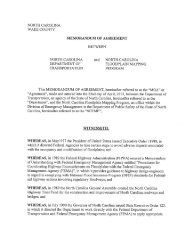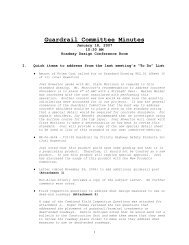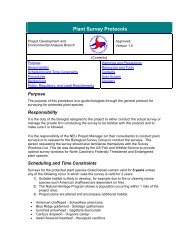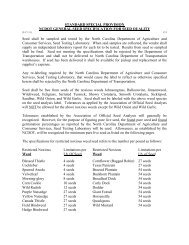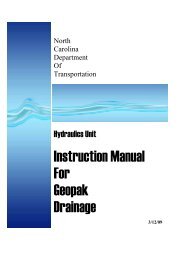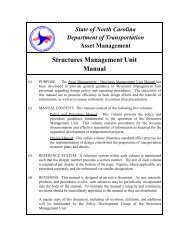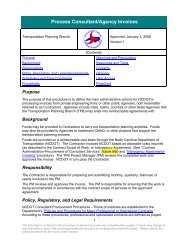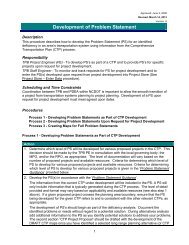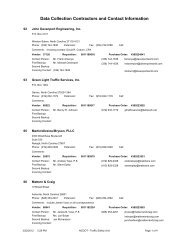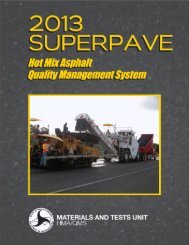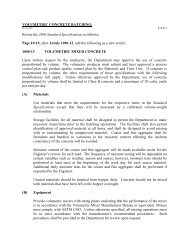Level of Service D Standard Tables - Connect NCDOT
Level of Service D Standard Tables - Connect NCDOT
Level of Service D Standard Tables - Connect NCDOT
You also want an ePaper? Increase the reach of your titles
YUMPU automatically turns print PDFs into web optimized ePapers that Google loves.
<strong>Level</strong> <strong>of</strong> <strong>Service</strong> D <strong>Standard</strong>s for<br />
Systems <strong>Level</strong> Planning<br />
Updated 10/14/2011
2<br />
Updated 10/14/2011
General Disclaimer<br />
The <strong>Level</strong> <strong>of</strong> <strong>Service</strong> D <strong>Standard</strong>s for Systems <strong>Level</strong> Planning was<br />
derived from the 2005 North Carolina <strong>Level</strong> <strong>of</strong> <strong>Service</strong> (NCLOS)<br />
Version 2.1 Program developed by the Institute for Transportation<br />
Research and Education (ITRE) at North Carolina State University.<br />
The NCLOS Program is based on the 2000 Highway Capacity<br />
Manual, published by the Transportation Research Board (TRB).<br />
These standards are intended for systems level planning only.<br />
Many assumptions are made and documented in the development <strong>of</strong><br />
these standards.<br />
CTP FACILITY TYPES<br />
FREEWAYS represent a multi-lane divided facility with complete<br />
access control (interchanges only and no traffic signals).<br />
EXPRESSWAYS represent a multi-lane divided facility with a high<br />
level <strong>of</strong> access control (interchanges, limited at-grade intersections,<br />
right-in/right out access, and no traffic signals).<br />
BOULEVARDS represent a typically divided facility with moderate<br />
access control (at-grade intersections, right-in/right out access, and<br />
traffic signals at major intersections).<br />
OTHER MAJOR THOROUGHFARES represent undivided facilities<br />
with four or more lanes (US and NC routes may have less than 4<br />
lanes). These facilities typically have low access control (at-grade<br />
intersections, access to development, and traffic signals at major and<br />
some minor intersections).<br />
MINOR THOROUGHFARES represent a 2-to-3 lane undivided facility<br />
that is not signed as a US or NC route. These facilities typically have<br />
low access control (at-grade intersections, access to development,<br />
and traffic signals at major and minor intersections).<br />
3<br />
Updated 10/14/2011
NCLOS (HCM) FACILITY TYPES<br />
FREEWAYS (Freeways) represent a multi-lane divided facility with<br />
complete access control (interchanges only and no traffic signals).<br />
EXPRESSWAYS (Multi-lane Highways) represent a multi-lane<br />
divided facility with a high level <strong>of</strong> access control (interchanges,<br />
limited at-grade intersections, right-in/right out access, and no traffic<br />
signals).<br />
BOULEVARDS (Arterials, 25-55 MPH) represent a typically divided<br />
facility with moderate access control (at-grade intersections, rightin/right<br />
out access, and traffic signals at major intersections).<br />
OTHER MAJOR THOROUGHFARES (Arterials, 25-55 MPH)<br />
represent undivided facilities with four or more lanes (US and NC<br />
routes may have less than 4 lanes). These facilities typically have<br />
low access control (at-grade intersections, access to development,<br />
and traffic signals at major and some minor intersections). These<br />
facilities are typically within an urban or suburban area (e.g. within a<br />
municipality or ETJ).<br />
MINOR THOROUGHFARES (Arterials 25-55 MPH) represent a 2-to-<br />
3 lane undivided facility that is not signed as a US or NC route.<br />
These facilities typically have low access control (at-grade<br />
intersections, access to development, and traffic signals at major and<br />
minor intersections). These facilities are typically within an urban or<br />
suburban area (e.g. within a municipality or ETJ).<br />
RURAL 2-LANE HIGHWAY (Two-Lane Highway, 55 MPH ONLY)<br />
represents a 2-lane undivided facility outside <strong>of</strong> a municipality or ETJ.<br />
These facilities have a 55 MPH posted speed limit, have low access<br />
control with numerous driveways and no traffic signals. These<br />
facilities are classified in a CTP as other major thoroughfares if<br />
they are a US or NC route or minor thoroughfares if they are a<br />
secondary or local route.<br />
4<br />
Updated 10/14/2011
AREA TYPE<br />
RURAL represents an area outside a municipality or Extraterritorial<br />
Jurisdiction (ETJ).<br />
SUBURBAN represents an area within a municipality or ETJ that is<br />
not within a Central Business District (CBD) or areas immediately<br />
surrounding a CBD.<br />
URBAN represents an area that is within a CBD or areas immediately<br />
surrounding a CBD.<br />
LEVEL OF SERVICE D VALUES<br />
MINIMUM CAPACITY VALUES represents conditions/inputs that<br />
result in a worst-case <strong>Level</strong> <strong>of</strong> <strong>Service</strong> D for a given facility. This<br />
lower value represents worst-case conditions in available data for a<br />
given region (Higher K/D Factors, Lower Peak Hour Factor, poor road<br />
conditions, etc.).<br />
STANDARD CAPACITY VALUES represents an average <strong>Level</strong> <strong>of</strong><br />
<strong>Service</strong> D for a given facility. This default value is an average <strong>of</strong><br />
available data for a given region.<br />
MAXIMUM CAPACITY VALUES represents conditions/inputs that<br />
result in a best-case <strong>Level</strong> <strong>of</strong> <strong>Service</strong> D for a given facility. This higher<br />
value represents best-case conditions in available data for a given<br />
region (Lower K/D Factors, Higher Peak Hour Factor, etc.).<br />
These assumptions may not pertain to all systems level planning<br />
work; therefore, separate analysis may need to be conducted on a<br />
case-by-case basis.<br />
These standards are not intended for project specific or corridor<br />
analysis. Separate analysis would be required for these types <strong>of</strong><br />
projects.<br />
Volumes shown represent the point at which traffic transitions from<br />
LOS D to LOS E.<br />
5<br />
Updated 10/14/2011
<strong>Level</strong> <strong>of</strong> <strong>Service</strong> D <strong>Standard</strong>s for Freeways *<br />
COASTAL<br />
2 Lanes Per Direction<br />
Urban Suburban Rural<br />
3 Lanes Per Direction<br />
Urban Suburban Rural<br />
4 Lanes Per Direction<br />
Urban Suburban Rural<br />
0-5% Trucks 67400 66900 67900 102000 101300 101800 137300 136200 135700<br />
6-10% Trucks 65700 65400 66200 99600 98900 99400 134000 133000 132500<br />
11-15% Trucks 64200 63800 64700 97300 96600 97100 130900 129900 129400<br />
16-20% Trucks 62800 62400 63200 95100 94400 94900 127900 126900 126500<br />
21-25% Trucks 61400 61000 61800 9300 92300 92700 125100 124100 123700<br />
26-30% Trucks 60000 59700 60500 90900 90300 90700 122400 121400 121000<br />
31-35% Trucks 58800 58400 59200 89000 88400 88800 119800 118800 118400<br />
PIEDMONT<br />
2 Lanes Per Direction<br />
Urban Suburban Rural<br />
3 Lanes Per Direction<br />
Urban Suburban Rural<br />
4 Lanes Per Direction<br />
Urban Suburban Rural<br />
0-5% Trucks 61700 61400 62200 93500 92900 93300 125800 124900 124400<br />
6-10% Trucks 60300 59900 60700 91300 90700 91100 122800 121900 121500<br />
11-15% Trucks 58900 58500 59300 89200 88600 89000 120000 119100 118600<br />
16-20% Trucks 57500 57200 58000 87100 86500 87000 117300 116400 115900<br />
21-25% Trucks 56300 55900 56700 85200 84600 85000 114700 113800 113400<br />
26-30% Trucks 55000 54700 55400 83400 82800 83200 112200 111300 110900<br />
31-35% Trucks 53900 53500 54300 81600 81000 81400 109800 108900 108500<br />
MOUNTAIN<br />
2 Lanes Per Direction 3 Lanes Per Direction 4 Lanes Per Direction<br />
(<strong>Level</strong> Terrain) Urban Suburban Rural Urban Suburban Rural Urban Suburban Rural<br />
0-5% Trucks 56100 61400 62200 85000 92900 93300 114400 124900 124400<br />
6-10% Trucks 54800 59900 60700 83000 90700 91100 111700 121900 121500<br />
11-15% Trucks 53500 58500 59300 81100 88600 89000 109100 119100 118600<br />
16-20% Trucks 52300 57200 58000 79200 86500 87000 106600 116400 115900<br />
21-25% Trucks 51100 55900 56700 77500 84600 85000 104200 113800 113400<br />
26-30% Trucks 50000 54700 55400 75800 82800 83200 102000 111300 110900<br />
31-35% Trucks 49000 53500 54300 74200 81000 81400 99800 108900 108500<br />
MOUNTAIN<br />
2 Lanes Per Direction 3 Lanes Per Direction 4 Lanes Per Direction<br />
(Rolling Terrian) Urban Suburban Rural Urban Suburban Rural Urban Suburban Rural<br />
0-5% Trucks 53500 58500 59300 81100 88600 89000 109100 119100 118600<br />
6-10% Trucks 50000 54700 55400 75800 82800 83200 102000 111300 110900<br />
11-15% Trucks 47000 51400 52100 71100 77700 78100 95700 104500 104100<br />
16-20% Trucks 44300 48400 49000 67000 73200 73600 90200 98500 98100<br />
21-25% Trucks 41800 45700 46400 63400 69200 69600 85300 93100 92700<br />
26-30% Trucks 39700 43400 44000 60100 65700 66000 80900 88300 87900<br />
31-35% Trucks 37700 41200 41800 57100 62400 62700 76900 83900 83600<br />
Uses "Freeways" Facility Type in NCLOS<br />
* Assumes Regional K and D Factor Averages<br />
See Appendix A1 for HCM 2000 Freeway Equations<br />
Use Appendix A2: Coastal Freeway Inputs for adjustments<br />
Use Appendix A3: Piedmont Freeway Inputs for adjustments<br />
Use Appendix A4: Mountain (<strong>Level</strong>) Freeway Inputs for adjustments<br />
Use Appendix A5: Mountain (Rolling) Freeway Inputs for adjustments<br />
NOTE: Truck percentage occurs within the peak hour, not a daily truck percentage<br />
6 Updated 10/14/2011
<strong>Level</strong> <strong>of</strong> <strong>Service</strong> D <strong>Standard</strong>s for Expressways *<br />
COASTAL<br />
2 Lanes Per Direction<br />
Urban Suburban Rural<br />
3 Lanes Per Direction<br />
Urban Suburban Rural<br />
4 Lanes Per Direction<br />
Urban Suburban Rural<br />
0-5% Trucks 47500 58500 58800 71200 87700 88300 95000 117000 117700<br />
6-10% Trucks 46400 57100 57400 69500 85600 86200 92700 114200 114900<br />
11-15% Trucks 45300 55800 56100 67900 83700 84200 90600 111500 112200<br />
16-20% Trucks 44200 54500 54800 66400 81800 82200 88500 109000 109700<br />
21-25% Trucks 43300 53300 53600 64900 79900 80400 86500 106600 107200<br />
26-30% Trucks 42300 52100 52400 63500 78200 78700 84700 104300 104900<br />
31-35% Trucks 41400 51000 51300 62100 76500 77000 82900 102100 102700<br />
PIEDMONT<br />
2 Lanes Per Direction<br />
Urban Suburban Rural<br />
3 Lanes Per Direction<br />
Urban Suburban Rural<br />
4 Lanes Per Direction<br />
Urban Suburban Rural<br />
0-5% Trucks 47500 58500 58800 71200 87700 88300 95000 117000 117700<br />
6-10% Trucks 46400 57100 57400 69500 85600 86200 92700 114200 114900<br />
11-15% Trucks 45300 55800 56100 67900 83700 84200 90600 111500 112200<br />
16-20% Trucks 44200 54500 54800 66400 81800 82200 88500 109000 109700<br />
21-25% Trucks 43300 53300 53600 64900 79900 80400 86500 106600 107200<br />
26-30% Trucks 42300 52100 52400 63500 78200 78700 84700 104300 104900<br />
31-35% Trucks 41400 51000 51300 62100 76500 77000 82900 102100 102700<br />
MOUNTAIN<br />
2 Lanes Per Direction 3 Lanes Per Direction 4 Lanes Per Direction<br />
(<strong>Level</strong> Terrain) Urban Suburban Rural Urban Suburban Rural Urban Suburban Rural<br />
0-5% Trucks 47500 53200 58800 71200 79800 88300 95000 106400 117700<br />
6-10% Trucks 46400 51900 57400 69500 77900 86200 92700 103800 114900<br />
11-15% Trucks 45300 50700 56100 67900 76100 84200 90600 101400 112200<br />
16-20% Trucks 44200 49500 54800 66400 74300 82200 88500 99100 109700<br />
21-25% Trucks 43300 48400 53600 64900 72700 80400 86500 96900 107200<br />
26-30% Trucks 42300 47400 52400 63500 71100 78700 84700 94800 104900<br />
31-35% Trucks 41400 46400 51300 62100 69600 77000 82900 92800 102700<br />
MOUNTAIN<br />
2 Lanes Per Direction 3 Lanes Per Direction 4 Lanes Per Direction<br />
(Rolling Terrian) Urban Suburban Rural Urban Suburban Rural Urban Suburban Rural<br />
0-5% Trucks 41200 50700 56100 61700 76100 84200 82300 101400 112200<br />
6-10% Trucks 38500 47400 52400 57700 71100 78700 77000 94800 110400<br />
11-15% Trucks 36100 44500 49200 54200 66700 73900 72200 89000 98500<br />
16-20% Trucks 34000 41900 46400 51100 62900 69600 68100 83900 92800<br />
21-25% Trucks 32200 39600 43900 48300 59500 65800 64400 79300 87700<br />
26-30% Trucks 30500 37600 41600 45800 56400 62400 61000 75200 83200<br />
31-35% Trucks 29000 35700 39600 43500 53600 59300 58000 71500 79100<br />
Uses "Multi-lane Highways" Facility Type in NCLOS<br />
* Assumes Regional K and D Factor Averages<br />
See Appendix B1 for HCM 2000 Multi-lane Highway Equations<br />
Use Appendix B2: Coastal Expressway Inputs for adjustments<br />
Use Appendix B3: Piedmont Expressway Inputs for adjustments<br />
Use Appendix B4: Mountain (<strong>Level</strong>) Expressway Inputs for adjustments<br />
Use Appendix B5: Mountain (Rolling) Expressway Inputs for adjustments<br />
NOTE: Truck percentage occurs within the peak hour, not a daily truck percentage<br />
7 Updated 10/14/2011
<strong>Level</strong> <strong>of</strong> <strong>Service</strong> D <strong>Standard</strong>s for Boulevards *<br />
COASTAL<br />
1 Lane Per Direction<br />
Urban Suburban Rural<br />
2 Lanes Per Direction<br />
Urban Suburban Rural<br />
3 Lanes Per Direction<br />
Urban Suburban Rural<br />
55 MPH 21600 21900 24500 43300 43900 49000 64900 65800 73500<br />
45 MPH 18900 19800 23600 38100 39700 47200 57200 59600 70800<br />
35 MPH 14000 16900 28100 34300 42200 51700<br />
25 MPH 12500 25400 38400<br />
PIEDMONT<br />
1 Lane Per Direction<br />
Urban Suburban Rural<br />
2 Lanes Per Direction<br />
Urban Suburban Rural<br />
3 Lanes Per Direction<br />
Urban Suburban Rural<br />
55 MPH 19900 20200 22600 40000 40500 45200 59900 60700 67900<br />
45 MPH 17500 18300 21800 35100 36600 43600 52800 55000 65400<br />
35 MPH 14000 15600 28100 31600 42200 47700<br />
25 MPH 12500 25400 38400<br />
MOUNTAIN<br />
1 Lane Per Direction<br />
Urban Suburban Rural<br />
2 Lanes Per Direction<br />
Urban Suburban Rural<br />
3 Lanes Per Direction<br />
Urban Suburban Rural<br />
55 MPH 21600 21900 22300 43300 43900 44500 64900 65800 66800<br />
45 MPH 18900 20700 21400 38100 41400 42900 57200 62100 64400<br />
35 MPH 14000 18500 28100 37400 42200 56400<br />
25 MPH 12500 25400 38400<br />
Uses "Principal Arterials" Facility Type in NCLOS<br />
* Assumes Regional K and D Factor Averages<br />
See Appendix C1 for HCM Urban Arterial Equations<br />
Use Appendix C2: Coastal Boulevard Inputs for adjustments<br />
Use Appendix C3: Piedmont Boulevard Inputs for adjustments<br />
Use Appendix C4: Mountain Boulevard Inputs for adjustments<br />
NOTE: Inputs assume 12-foot lanes. To adjust lane-width downward, subtract 3.33% per foot <strong>of</strong> pavement<br />
and round to the nearest hundred<br />
8 Updated 10/14/2011
Coastal <strong>Level</strong> <strong>of</strong> <strong>Service</strong> D <strong>Standard</strong>s<br />
for Other Major Thoroughfares *<br />
55 MPH<br />
1 Lane Per Direction<br />
Urban Suburban Rural<br />
1 Lane Per Direction WCLTL<br />
Urban Suburban Rural<br />
12 foot lanes 15100 15800 16400 16600 17200 17800<br />
11 foot lanes 14600 15300 15900 16100 16600 17200<br />
10 foot lanes 14100 14700 15300 15500 16100 16600<br />
9 foot lanes 13600 14200 14800 15000 15500 16000<br />
45 MPH<br />
Urban Suburban Rural Urban Suburban Rural<br />
12 foot lanes 13200 13800 14600 14500 14900 16000<br />
11 foot lanes 12800 13300 14100 14000 14400 15500<br />
10 foot lanes 12300 12900 13600 13500 13900 15000<br />
9 foot lanes 11900 12420 13140 13050 13400 14400<br />
35 MPH<br />
Urban Suburban Rural Urban Suburban Rural<br />
12 foot lanes 11100 12600 12700 14000<br />
11 foot lanes 10700 12200 12300 13500<br />
10 foot lanes 10400 11800 11900 13100<br />
9 foot lanes 10000 11300 11400 12600<br />
25 MPH<br />
1 Lane Per Direction 1 Lane Per Direction WCLTL<br />
1 Lane Per Direction<br />
Urban Suburban Rural Urban Suburban Rural<br />
12 foot lanes 11000 12700<br />
11 foot lanes 10600 12300<br />
10 foot lanes 10300 11900<br />
9 foot lanes 9900 11400<br />
Uses "Principal Arterials" Facility Type in NCLOS<br />
1 Lane Per Direction WCLTL<br />
1 Lane Per Direction 1 Lane Per Direction WCLTL<br />
* Decrease in Lane Width Capacity calculated via 2000 Highway Capacity Manual<br />
lane-width adjustment factor for saturation flow rate<br />
See Appendix D1 for HCM 2000 Urban Arterial Equations<br />
Use Appendix D2: Coastal Major Thoroughfare Inputs for adjustments<br />
NOTE: Lane Width is adjusted downward by 3.33% per less foot <strong>of</strong> pavement<br />
and rounded to the nearest hundred<br />
9 Updated 10/14/2011
Coastal <strong>Level</strong> <strong>of</strong> <strong>Service</strong> D <strong>Standard</strong>s<br />
for Other Major Thoroughfares *<br />
55 MPH<br />
2 Lanes Per Direction<br />
Urban Suburban Rural<br />
2 Lanes Per Direction WCLTL<br />
Urban Suburban Rural<br />
12 foot lanes 30400 31600 32800 33300 34500 35700<br />
11 foot lanes 29400 30600 31700 32200 33400 34500<br />
10 foot lanes 29400 29500 30600 31100 32200 33300<br />
9 foot lanes 27400 28400 29500 30000 31100 32100<br />
45 MPH<br />
Urban Suburban Rural Urban Suburban Rural<br />
12 foot lanes 26700 27600 29300 29000 29900 32000<br />
11 foot lanes 25900 26700 28300 28000 28900 30900<br />
10 foot lanes 25000 25800 27300 27100 27900 29900<br />
9 foot lanes 24000 24800 26400 26100 26900 29000<br />
35 MPH<br />
Urban Suburban Rural Urban Suburban Rural<br />
12 foot lanes 22200 25500 24300 28100<br />
11 foot lanes 21500 24700 23500 27200<br />
10 foot lanes 20700 23800 22700 26200<br />
9 foot lanes 20000 23000 21900 25300<br />
25 MPH<br />
2 Lanes Per Direction 2 Lanes Per Direction WCLTL<br />
2 Lanes Per Direction 2 Lanes Per Direction WCLTL<br />
2 Lanes Per Direction 2 Lanes Per Direction WCLTL<br />
Urban Suburban Rural Urban Suburban Rural<br />
12 foot lanes 22100 24200<br />
11 foot lanes 21400 23400<br />
10 foot lanes 20500 22600<br />
9 foot lanes 19900 21800<br />
Uses "Principal Arterials" Facility Type in NCLOS<br />
* Decrease in Lane Width Capacity calculated via 2000 Highway Capacity Manual<br />
lane-width adjustment factor for saturation flow rate<br />
See Appendix D1 for HCM 2000 Urban Arterial Equations<br />
Use Appendix D2: Coastal Major Thoroughfare Inputs for adjustments<br />
NOTE: Lane Width is adjusted downward by 3.33% per less foot <strong>of</strong> pavement<br />
and rounded to the nearest hundred<br />
10 Updated 10/14/2011
Piedmont <strong>Level</strong> <strong>of</strong> <strong>Service</strong> D <strong>Standard</strong>s<br />
for Other Major Thoroughfares *<br />
55 MPH<br />
1 Lane Per Direction<br />
Urban Suburban Rural<br />
1 Lane Per Direction WCLTL<br />
Urban Suburban Rural<br />
12 foot lanes 12900 14600 15100 14200 15900 16500<br />
11 foot lanes 12500 14100 14600 13700 15400 16000<br />
10 foot lanes 12000 13600 14100 13300 14800 15400<br />
9 foot lanes 11600 13100 13600 12800 14300 14900<br />
45 MPH<br />
Urban Suburban Rural Urban Suburban Rural<br />
12 foot lanes 12200 12700 14600 13300 13800 16000<br />
11 foot lanes 11800 12300 14100 12900 13300 15500<br />
10 foot lanes 11400 11900 13600 12400 12900 14900<br />
9 foot lanes 11000 11400 13100 12000 12400 14400<br />
35 MPH<br />
Urban Suburban Rural Urban Suburban Rural<br />
12 foot lanes 11100 11600 12700 12900<br />
11 foot lanes 10700 11200 12300 12500<br />
10 foot lanes 10400 10800 11900 12000<br />
9 foot lanes 10000 10400 11400 11600<br />
25 MPH<br />
1 Lane Per Direction 1 Lane Per Direction WCLTL<br />
1 Lane Per Direction 1 Lane Per Direction WCLTL<br />
1 Lane Per Direction 1 Lane Per Direction WCLTL<br />
Urban Suburban Rural Urban Suburban Rural<br />
12 foot lanes 11000 12700<br />
11 foot lanes 10600 12300<br />
10 foot lanes 10300 11900<br />
9 foot lanes 9900 11400<br />
Uses "Principal Arterials" Facility Type in NCLOS<br />
* Decrease in Lane Width Capacity calculated via 2000 Highway Capacity Manual<br />
lane-width adjustment factor for saturation flow rate<br />
See Appendix D1 for HCM 2000 Urban Arterial Equations<br />
Use Appendix D3: Piedmont Major Thoroughfare Inputs for adjustments<br />
NOTE: Lane Width is adjusted downward by 3.33% per less foot <strong>of</strong> pavement<br />
11 Updated 10/14/2011
Piedmont <strong>Level</strong> <strong>of</strong> <strong>Service</strong> D <strong>Standard</strong>s<br />
for Other Major Thoroughfares *<br />
55 MPH<br />
2 Lanes Per Direction<br />
Urban Suburban Rural<br />
2 Lanes Per Direction WCLTL<br />
Urban Suburban Rural<br />
12 foot lanes 25800 29100 30200 28400 31800 33000<br />
11 foot lanes 24900 28100 29200 27500 30800 31900<br />
10 foot lanes 24100 27200 28200 26500 29700 30800<br />
9 foot lanes 23200 26200 27200 25600 28600 29700<br />
45 MPH<br />
Urban Suburban Rural Urban Suburban Rural<br />
12 foot lanes 24600 25500 29300 26800 27600 32000<br />
11 foot lanes 23800 24700 28300 25900 26700 31000<br />
10 foot lanes 23000 23800 27300 25000 25800 29900<br />
9 foot lanes 22100 23000 26400 24100 24800 28800<br />
35 MPH<br />
Urban Suburban Rural Urban Suburban Rural<br />
12 foot lanes 22200 23500 24300 26000<br />
11 foot lanes 21500 22700 23500 25100<br />
10 foot lanes 20700 21900 22700 24300<br />
9 foot lanes 20000 21200 21900 23400<br />
25 MPH<br />
2 Lanes Per Direction 2 Lanes Per Direction WCLTL<br />
2 Lanes Per Direction 2 Lanes Per Direction WCLTL<br />
2 Lanes Per Direction 2 Lanes Per Direction WCLTL<br />
Urban Suburban Rural Urban Suburban Rural<br />
12 foot lanes 22100 24200<br />
11 foot lanes 21400 23400<br />
10 foot lanes 20600 22600<br />
9 foot lanes 19900 21800<br />
Uses "Principal Arterials" Facility Type in NCLOS<br />
* Decrease in Lane Width Capacity calculated via 2000 Highway Capacity Manual<br />
lane-width adjustment factor for saturation flow rate<br />
See Appendix D1 for HCM 2000 Urban Arterial Equations<br />
Use Appendix D3: Piedmont Major Thoroughfare Inputs for adjustments<br />
NOTE: Lane Width is adjusted downward by 3.33% per less foot <strong>of</strong> pavement<br />
and rounded to the nearest hundred<br />
12 Updated 10/14/2011
Mountain <strong>Level</strong> <strong>of</strong> <strong>Service</strong> D <strong>Standard</strong>s<br />
for Other Major Thoroughfares *<br />
55 MPH<br />
1 Lane Per Direction<br />
Urban Suburban Rural<br />
1 Lane Per Direction WCLTL<br />
Urban Suburban Rural<br />
12 foot lanes 14000 14600 15100 15300 15900 16500<br />
11 foot lanes 13500 14100 14600 14800 15400 16000<br />
10 foot lanes 13100 13600 14100 14300 14800 15400<br />
9 foot lanes 12600 13100 13600 13800 14300 14900<br />
45 MPH<br />
Urban Suburban Rural Urban Suburban Rural<br />
12 foot lanes 12200 12700 14600 13300 13800 16000<br />
11 foot lanes 11800 12300 14100 12900 13300 15500<br />
10 foot lanes 11400 11900 13600 12400 12900 14900<br />
9 foot lanes 11000 11400 13100 12000 12400 14400<br />
35 MPH<br />
Urban Suburban Rural Urban Suburban Rural<br />
12 foot lanes 11000 11600 12700 12900<br />
11 foot lanes 10600 11200 12300 12500<br />
10 foot lanes 10300 10800 11900 12000<br />
9 foot lanes 9900 10400 11400 11600<br />
25 MPH<br />
1 Lane Per Direction 1 Lane Per Direction WCLTL<br />
1 Lane Per Direction 1 Lane Per Direction WCLTL<br />
1 Lane Per Direction<br />
Urban Suburban Rural Urban Suburban Rural<br />
12 foot lanes 11000 12700<br />
11 foot lanes 10600 12300<br />
10 foot lanes 10300 11900<br />
9 foot lanes 9900 11400<br />
Uses "Principal Arterials" Facility Type in NCLOS<br />
1 Lane Per Direction WCLTL<br />
* Decrease in Lane Width Capacity calculated via 2000 Highway Capacity Manual<br />
lane-width adjustment factor for saturation flow rate<br />
See Appendix D1 for HCM 2000 Urban Arterial Equations<br />
Use Appendix D4: Mountains Major Thoroughfare Inputs for adjustments<br />
NOTE: Lane Width is adjusted downward by 3.33% per less foot <strong>of</strong> pavement<br />
and rounded to the nearest hundred<br />
13 Updated 10/14/2011
Mountain <strong>Level</strong> <strong>of</strong> <strong>Service</strong> D <strong>Standard</strong>s<br />
for Other Major Thoroughfares *<br />
55 MPH<br />
2 Lanes Per Direction<br />
Urban Suburban Rural<br />
2 Lanes Per Direction WCLTL<br />
Urban Suburban Rural<br />
12 foot lanes 28000 29100 30200 30800 31800 33000<br />
11 foot lanes 27100 28100 29200 29800 30800 31900<br />
10 foot lanes 26100 27200 28200 28700 29700 30800<br />
9 foot lanes 25200 26200 27200 27700 28600 29700<br />
45 MPH<br />
Urban Suburban Rural Urban Suburban Rural<br />
12 foot lanes 24600 25500 29300 26800 27600 32000<br />
11 foot lanes 23800 24700 28300 25900 26700 30900<br />
10 foot lanes 23000 23800 27300 25000 25800 29900<br />
9 foot lanes 22100 23000 26400 24100 24800 28800<br />
35 MPH<br />
Urban Suburban Rural Urban Suburban Rural<br />
12 foot lanes 22200 23500 24300 26000<br />
11 foot lanes 21500 22700 23500 25400<br />
10 foot lanes 20700 21900 22700 24300<br />
9 foot lanes 20000 21200 21900 23400<br />
25 MPH<br />
2 Lanes Per Direction 2 Lanes Per Direction WCLTL<br />
2 Lanes Per Direction 2 Lanes Per Direction WCLTL<br />
2 Lanes Per Direction<br />
Urban Suburban Rural Urban Suburban Rural<br />
12 foot lanes 22100 24200<br />
11 foot lanes 21400 23400<br />
10 foot lanes 20600 22600<br />
9 foot lanes 19900 21800<br />
Uses "Principal Arterials" Facility Type in NCLOS<br />
2 Lanes Per Direction WCLTL<br />
* Decrease in Lane Width Capacity calculated via 2000 Highway Capacity Manual<br />
lane-width adjustment factor for saturation flow rate<br />
See Appendix D1 for HCM 2000 Urban Arterial Equations<br />
Use Appendix D4: Mountains Major Thoroughfare Inputs for adjustments<br />
NOTE: Lane Width is adjusted downward by 3.33% per less foot <strong>of</strong> pavement<br />
14 Updated 10/14/2011
Coastal <strong>Level</strong> <strong>of</strong> <strong>Service</strong> D <strong>Standard</strong>s<br />
for Minor Thoroughfares *<br />
55 MPH<br />
1 Lane Per Direction<br />
Urban Suburban Rural<br />
1 Lane Per Direction WCLTL<br />
Urban Suburban Rural<br />
12 foot lanes 15100 15800 16400 16600 17200 17800<br />
11 foot lanes 14600 15300 15900 16100 16600 17200<br />
10 foot lanes 14100 14700 15300 15500 16100 16600<br />
9 foot lanes 13600 14200 14800 14900 15500 16000<br />
45 MPH<br />
1 Lane Per Direction<br />
Urban Suburban Rural<br />
1 Lane Per Direction WCLTL<br />
Urban Suburban Rural<br />
12 foot lanes 12700 13300 14600 14200 14300 16000<br />
11 foot lanes 12300 12900 14100 13700 13800 15500<br />
10 foot lanes 11900 12400 13600 13300 13300 14900<br />
9 foot lanes 11400 12000 13100 12800 12900 14400<br />
35 MPH<br />
1 Lane Per Direction<br />
Urban Suburban Rural<br />
1 Lane Per Direction WCLTL<br />
Urban Suburban Rural<br />
12 foot lanes 10500 11000 11500 13700<br />
11 foot lanes 10200 10600 11100 13300<br />
10 foot lanes 9800 10300 10700 12800<br />
9 foot lanes 9500 9900 10400 12300<br />
25 MPH<br />
1 Lane Per Direction<br />
Urban Suburban Rural<br />
1 Lane Per Direction WCLTL<br />
Urban Suburban Rural<br />
12 foot lanes 10000 11300<br />
11 foot lanes 9700 10900<br />
10 foot lanes 9300 10500<br />
9 foot lanes 9000 10200<br />
Uses "Principal Arterials" and "Minor Arterials" Facility Types in NCLOS<br />
* Decrease in Lane Width Capacity calculated via 2000 Highway Capacity Manual<br />
lane-width adjustment factor for saturation flow rate<br />
See Appendix E1 for HCM 2000 Urban Arterial Equations<br />
Use Appendix E2: Coastal Minor Thoroughfare Inputs for adjustments<br />
NOTE: Lane Width is adjusted downward by 3.33% per less foot <strong>of</strong> pavement<br />
15 Updated 10/14/2011
Piedmont <strong>Level</strong> <strong>of</strong> <strong>Service</strong> D <strong>Standard</strong>s<br />
for Minor Thoroughfares *<br />
55 MPH<br />
1 Lane Per Direction<br />
Urban Suburban Rural<br />
1 Lane Per Direction WCLTL<br />
Urban Suburban Rural<br />
12 foot lanes 12900 14600 15100 14200 15900 16500<br />
11 foot lanes 12500 14100 14600 13700 15400 16000<br />
10 foot lanes 12000 13600 14100 13300 14800 15400<br />
9 foot lanes 11600 13100 13600 12800 14300 14900<br />
45 MPH<br />
1 Lane Per Direction<br />
Urban Suburban Rural<br />
1 Lane Per Direction WCLTL<br />
Urban Suburban Rural<br />
12 foot lanes 11700 12200 14600 13100 13200 16000<br />
11 foot lanes 11300 11800 14100 12700 12800 15500<br />
10 foot lanes 10900 11400 13600 12200 12300 14900<br />
9 foot lanes 10500 11000 13100 11800 11900 14400<br />
35 MPH<br />
1 Lane Per Direction<br />
Urban Suburban Rural<br />
1 Lane Per Direction WCLTL<br />
Urban Suburban Rural<br />
12 foot lanes 10200 10200 11700 12700<br />
11 foot lanes 9900 9900 11300 12300<br />
10 foot lanes 9500 9500 10900 11900<br />
9 foot lanes 9200 9200 10500 11400<br />
25 MPH<br />
1 Lane Per Direction<br />
Urban Suburban Rural<br />
1 Lane Per Direction WCLTL<br />
Urban Suburban Rural<br />
12 foot lanes 10000 11300<br />
11 foot lanes 9700 10900<br />
10 foot lanes 9300 10500<br />
9 foot lanes 9000 10200<br />
Uses "Principal Arterials" and "Minor Arterials" Facility Types in NCLOS<br />
* Decrease in Lane Width Capacity calculated via 2000 Highway Capacity Manual<br />
lane-width adjustment factor for saturation flow rate<br />
See Appendix E1 for HCM 2000 Urban Arterial Equations<br />
Use Appendix E3: Piedmont Minor Thoroughfare Inputs for adjustments<br />
NOTE: Lane Width is adjusted downward by 3.33% per less foot <strong>of</strong> pavement<br />
16 Updated 10/14/2011
Mountain <strong>Level</strong> <strong>of</strong> <strong>Service</strong> D <strong>Standard</strong>s<br />
for Minor Thoroughfares *<br />
55 MPH<br />
1 Lane Per Direction<br />
Urban Suburban Rural<br />
1 Lane Per Direction WCLTL<br />
Urban Suburban Rural<br />
12 foot lanes 14000 14600 15100 15300 15900 16500<br />
11 foot lanes 13500 14100 14600 14800 15400 16000<br />
10 foot lanes 13100 13600 14100 14300 14800 15400<br />
9 foot lanes 12600 13100 13600 13800 14300 14900<br />
45 MPH<br />
1 Lane Per Direction<br />
Urban Suburban Rural<br />
1 Lane Per Direction WCLTL<br />
Urban Suburban Rural<br />
12 foot lanes 11700 12200 14600 13100 13200 16000<br />
11 foot lanes 11300 11800 14100 12700 12800 15500<br />
10 foot lanes 10900 11400 13600 12200 12300 14900<br />
9 foot lanes 10500 11000 13100 11800 11900 14400<br />
35 MPH<br />
1 Lane Per Direction<br />
Urban Suburban Rural<br />
1 Lane Per Direction WCLTL<br />
Urban Suburban Rural<br />
12 foot lanes 10200 10200 11500 12700<br />
11 foot lanes 9900 9900 11100 12300<br />
10 foot lanes 9500 9500 10700 11900<br />
9 foot lanes 9200 9200 10400 11400<br />
25 MPH<br />
1 Lane Per Direction<br />
Urban Suburban Rural<br />
1 Lane Per Direction WCLTL<br />
Urban Suburban Rural<br />
12 foot lanes 10000 11300<br />
11 foot lanes 9700 10900<br />
10 foot lanes 9300 10500<br />
9 foot lanes 9000 10200<br />
Uses "Principal Arterials" and "Minor Arterials" Facility Types in NCLOS<br />
* Decrease in Lane Width Capacity calculated via 2000 Highway Capacity Manual<br />
lane-width adjustment factor for saturation flow rate<br />
See Appendix E1 for HCM 2000 Urban Arterial Equations<br />
Use Appendix E4: Mountain Minor Thoroughfare Inputs for adjustments<br />
NOTE: Lane Width is adjusted downward by 3.33% per less foot <strong>of</strong> pavement<br />
17 Updated 10/14/2011
<strong>Level</strong> <strong>of</strong> <strong>Service</strong> D <strong>Standard</strong>s for Rural 2-Lane Highways<br />
Uses "2-Lane Highways" Facility Type in NCLOS<br />
Coastal 2-Lane<br />
COASTAL<br />
Highway <strong>Standard</strong> Minimum <strong>Standard</strong> Maximum<br />
12-Foot Lanes<br />
11-Foot Lanes<br />
10-Foot Lanes<br />
10500<br />
10000<br />
9200<br />
12700*<br />
12000<br />
14700*#<br />
9-Foot Lanes 7700 10700<br />
Piedmont 2-Lane<br />
PIEDMONT<br />
Highway <strong>Standard</strong> Minimum <strong>Standard</strong> Maximum<br />
12-Foot Lanes<br />
11-Foot Lanes<br />
10-Foot Lanes<br />
10300<br />
9900<br />
9000<br />
12400*<br />
11800<br />
14300*#<br />
9-Foot Lanes 7500 10500<br />
Mountain 2-Lane MOUNTAINS (<strong>Level</strong>)<br />
Highway <strong>Standard</strong> Minimum <strong>Standard</strong> Maximum<br />
12-Foot Lanes<br />
11-Foot Lanes<br />
10-Foot Lanes<br />
10200<br />
9800<br />
8800<br />
12100*<br />
11700<br />
14000*#<br />
9-Foot Lanes 7400 10300<br />
Mountain 2-Lane MOUNTAINS (Rolling)<br />
Highway <strong>Standard</strong> Minimum <strong>Standard</strong> Maximum<br />
12-Foot Lanes<br />
11-Foot Lanes<br />
10-Foot Lanes<br />
9600<br />
9100<br />
8200<br />
12100*<br />
11100<br />
14000*#<br />
9-Foot Lanes 6300 9800<br />
* All capacities calculated based on HCM 2000 procedures using HCS s<strong>of</strong>tware. Under some conditions,<br />
two-lane highway capacity is not affected by lane width. This occurs where capacity is governed by<br />
Percent Time Spent Following rather than by Average Travel Speed.<br />
# Best-case/Maximum conditions are less likely to occur where lane widths are below 11 feet.<br />
Use caution before selecting "Maximum" values for 9-ft or 10-ft lanes.<br />
See Appendix F1 for HCM 2000 2-Lane Highway Equations<br />
Use Appendix F2: Coastal Rural 2-Lane Highway Inputs for adjustments<br />
Use Appendix F3: Piedmont Rural 2-Lane Highway Inputs for adjustments<br />
Use Appendix F4: Mountain (<strong>Level</strong>) Rural 2-Lane Highway Inputs for adjustments<br />
Use Appendix F5: Mountain (Rolling) Rural 2-Lane Highway Inputs for adjustments<br />
18 Updated 10/14/2011



